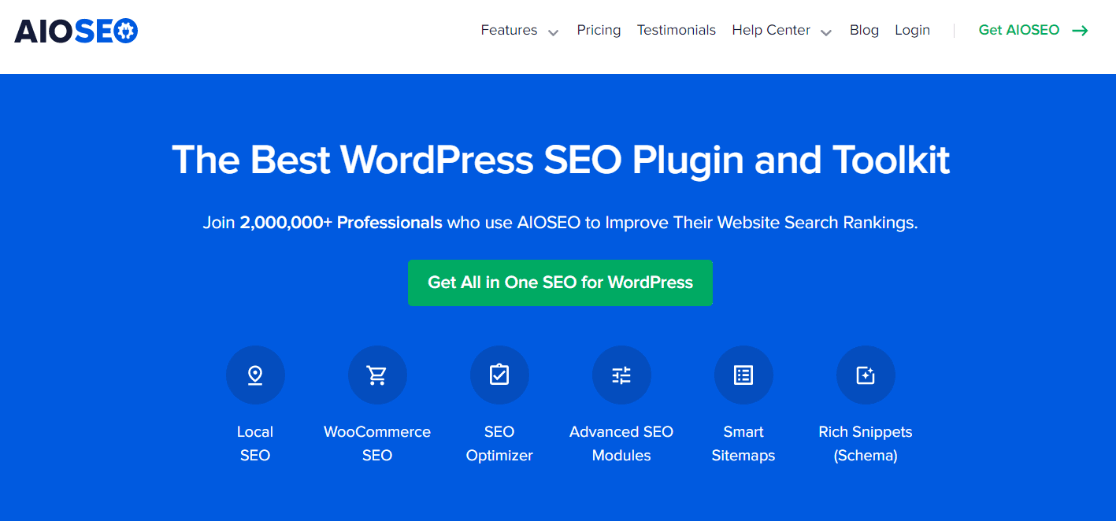If you follow along with SEO news and best practices, you might have seen the term “cornerstone content” used. It sounds like a fancy SEO term, but what does it actually mean? And how do you create cornerstone content?
There are many SEO tips and tactics out there, and it can take effort to figure out which are important for you and your website. I’m glad you’re here to learn about cornerstone content, though, because it’s one of the most beneficial tactics!
In this article, I’ll sum up cornerstone content for you. I’ll tell you what it is, why it’s essential, and how you can create it. I’ll also go over a few cornerstone content examples.
If you’re a WordPress user, make sure to stick around and check out our last section about how you can create cornerstone content specifically in WordPress.
Table of Contents
- What is Cornerstone Content?
- What Are the Benefits of Cornerstone Content?
- How to Create Cornerstone Content That Ranks
- How to Add Cornerstone Content to WordPress
- Cornerstone Content Examples
What is Cornerstone Content?
Cornerstone content is a set of articles published on your website that contain your most important keywords and topics. They’re central to your content strategy, and it’s crucial to keep them updated and try to rank them in Google search results.
Cornerstone content is often longer and more in-depth than a lot of your other content.
Cornerstone content can also be compared to a hub. It’s at the center of one particular topic, and all the other content you create around the same subject supports the hub.
For example, your cornerstone content piece might be called “The Ultimate Guide to WordPress SEO,” and supporting pieces might be “Top 10 Basic WordPress SEO Tips” and “How to Add WordPress Internal Links to Improve Your SEO”.
What Are the Benefits of Cornerstone Content?
Using the cornerstone content model on your website comes with many cool, incredibly valuable benefits.
1. Increases E-E-A-T
Google E-E-A-T (Experience, Expertise, Authoritativeness, and Trustworthiness) is a concept that Google uses to explain how it chooses the best content to rank on the first page of search results.
By creating cornerstone content, you’re indicating to Google that you’re an expert on the subject. Your cornerstone content is also more likely to be linked to from other websites, leading Google to see that you’re trustworthy.
For more on E-E-A-T, check out AIOSEO’s E-E-A-T guide.
2. Helps Users Navigate Your Site
Your cornerstones are likely to be your top landing pages. By using cornerstone content as a hub and linking to many of your other important content on the same subject, you’re providing visitors with a natural path through your site based on their interests.
It works the other way around, as well. Visitors will click on your links from other articles to check out your cornerstone content.
Not only is this helpful for users, but it also might boost your rankings! If people are sticking around on your site, engaging with your content, and clicking through to more pages, Google may use that as a positive ranking signal.
3. Is More Likely to Rank
If you’re diving into creating cornerstone content and following all of the best practices we go over in this article, then your cornerstone content is much more likely to rank than if it’s just a regular piece of content.
Creating cornerstone content naturally takes more time and effort than regular content. That extra time and effort should pay off with increased rankings, though, which means more traffic and more revenue!
How to Create Cornerstone Content That Ranks
Ready to get started on your cornerstone content? Let’s dive into our tutorial.
Step 1: Choose 3 – 5 Cornerstone Topics
Your first step in creating cornerstone content is choosing your target topics and keywords. These should be topics central to your work and include keywords with higher search volumes.
Keep your cornerstone content topics broad so that you can cover a lot of information within them and have a lot of supporting content that links back to your cornerstone.
For example, our plugin, MonsterInsights, is a Google Analytics plugin for WordPress. So, one of our cornerstone content pieces is How to Add Google Analytics to WordPress the Right Way.
It’s very central to what we do, there are some high-volume keywords that it can rank for, and there are a lot of topics we can explore about using Google Analytics on WordPress. All of that makes it an excellent cornerstone content piece!
Step 2: Research, Research, Research
Before you can finish and optimize your cornerstone content, conduct some keyword research to ensure you have all of the necessary keywords, your content lives up to the competition, and it has the right keyword intent.
Keywords: In addition to your focus keyword, ensure you’ve found all of its variants and super closely related topics to go over in your article.
For help with keyword research, check out How to Do Keyword Research for SEO: Quick-Start Guide.
Competition: If you want to outrank your competition, your article needs to compete with theirs in terms of topics covered, keywords used, and general awesomeness.
For more on competitor research, check out How to Track Competitor Website Traffic and Ethically Steal It.
Keyword Intent: What kind of content are users expecting to find when they type your focus keyword into Google? Are the top 10 results for your keyword mostly listicles, ultimate guides, videos, or something else? Try to align with what’s there, but make yours better.
Also, make sure to think about what the searcher really needs when they type in your keyword. Are they just looking for information, or are they ready to buy something? This will shape the main point of your entire article.
For more on writing for the right keyword intent, check out How to Master SEO Search Intent to Improve Your Rankings.
Step 3: Write a Longer, Detailed Article
Cornerstone content is typically lengthy and detailed in order to rank for not only your focus keyword but related keywords as well. These articles also often serve as hubs — they dip into different topics, and then you write entire articles on those topics separately and add internal links between the two pieces.
In the article, separate different ideas with headings, include your focus keyword frequently, link to studies or other data, and generally show Google that you’re an expert on the topic.
We’ll give you a few more writing tips in the next section.
How to Add Cornerstone Content in WordPress
The first steps in adding cornerstone content to WordPress are the same as any other content: write it using your keywords, give it descriptive headings, and make it look great in WordPress.
Beyond that, here are a few extra tips for your cornerstone content pieces in WordPress:
- Include a table of contents: Cornerstone content is often on the longer side, so a table of contents can help readers and search engines easily see what’s included in the article.
- Craft a super compelling meta title and description: Although Google may change your meta description to closely match the searcher’s query, think of your meta title and description as an ad, persuading searchers to click on your result.
- Optimize your images: Every little bit of SEO-ing you can do to your article is helpful, including optimizing your images. Images can also be included in featured snippets, so ensure your image SEO is dialed in.
- Use an SEO plugin to analyze your article: Using an SEO plugin like All in One SEO to analyze your article can greatly help get it to rank. It’ll tell you if your focus keyphrase is in all the right places if your images are optimized, if your readability is excellent, and more.
When your content is created and well optimized, there’s a special way you can add it as cornerstone content by using the All in One SEO plugin.
Step 1: Install AIOSEO
If you haven’t installed All in One SEO yet, it’s time to start. While they have a Lite version of the plugin, you’ll need to grab the Pro version to access the Cornerstone Content feature (and a TON of other beneficial features). With AIOSEO Pro, you’ll also get features like:
- Easy SEO audits
- Schema
- Redirect manager
- Internal link assistant
- Advanced sitemaps
- WooCommerce SEO
- And much more
Step 2: Switch Cornerstone Content On
Now, you can use AIOSEO to indicate which articles you want to mark as cornerstone content. Just open the article, scroll down to the AIOSEO settings box, and toggle the Cornerstone Content switch on:
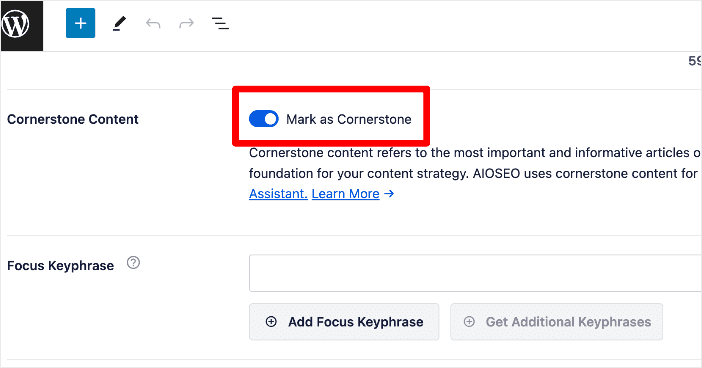
Step 3: Use AIOSEO to Improve Your Cornerstone Content
Now that you’ve marked your most important articles as cornerstone content, the All in One SEO plugin will help you turn them into high performers.
First, note that you can now access your cornerstones quickly on your WordPress posts page:
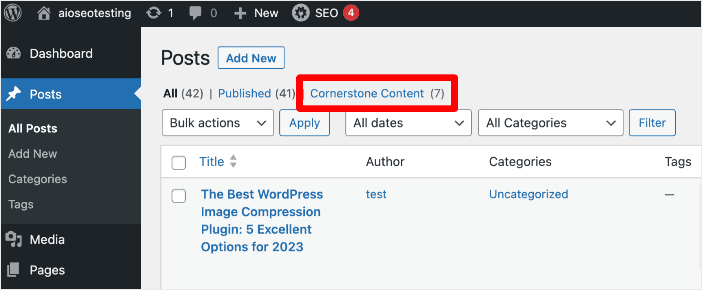
So, if you need to update those articles, you can quickly and easily find them in your list.
Before we do anything else, make sure to open each cornerstone article, input your focus keyphrase, and make any essential updates that AIOSEO suggests:
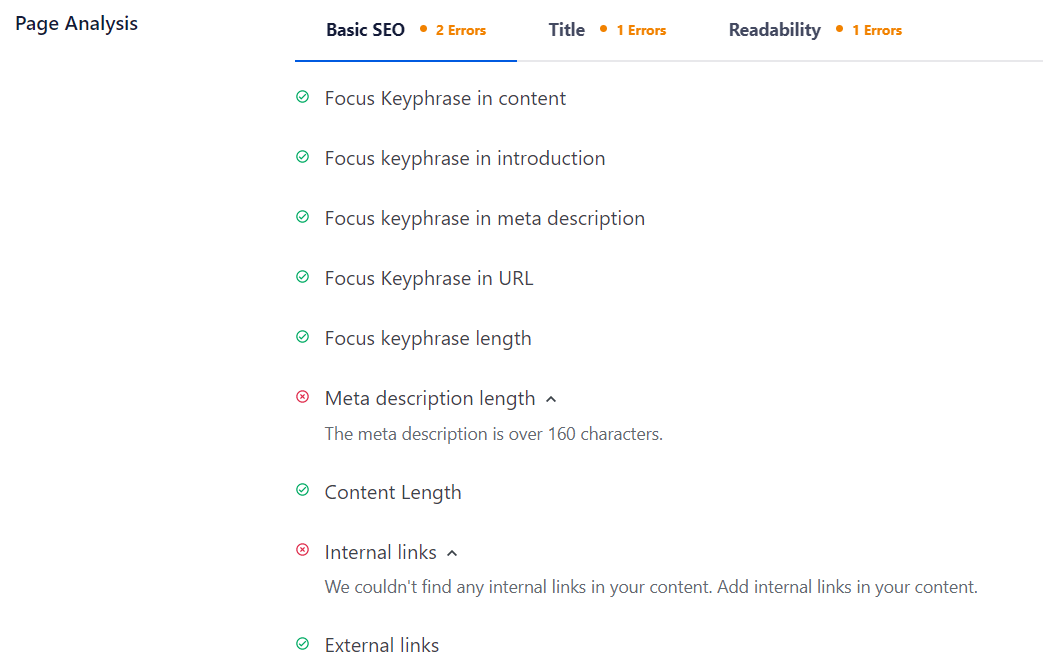
Next, let’s take a look at the heart of your cornerstone content strategy: internal links.
Besides shaping your article into a fantastic piece of content, the most crucial part of cornerstone content is links. If you want that article to act as a cornerstone for your site, you want to link many other pages and posts to it. This not only shows search engines that the content is essential, but it also sends your human traffic there.
To build those crucial links, head to the Link Assistant tab in the AIOSEO settings at the bottom of your article:
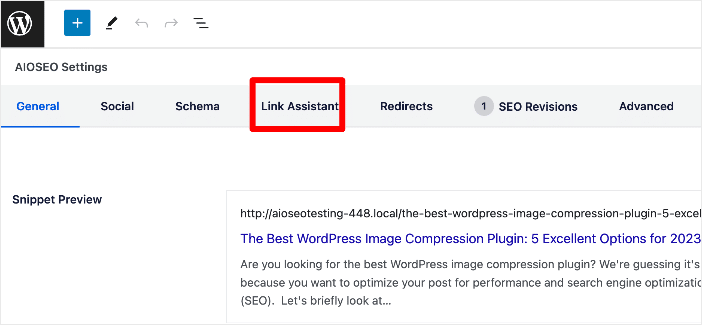
Then, head to the Link Suggestions tab and click on Inbound Internal Suggestions:
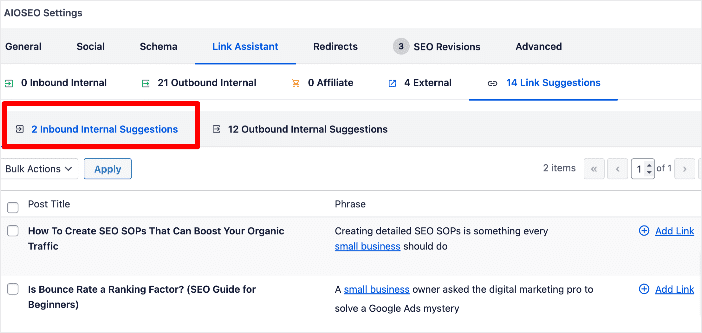
This is where it gets incredibly easy to build your internal links. All you have to do is click the blue Add Link button next to each suggestion, and it’ll be added to the article without opening it.
Want to edit the sentence or linked words? Just click into the Phrase and change it how you’d like before clicking Add Link.
That’s it – internal links added!
For more on using the AIOSEO Link Assistant, check out How to Use Link Assistant to Optimize Your Internal Linking Strategy.
Cornerstone Content Examples
Do you want to scope out some examples of cornerstone content? Here are a few that are great examples!
- WPBeginner’s How to Make a WordPress Website (Ultimate Guide): This guide to making a WordPress website is excellent cornerstone content for a website that covers just about everything about WordPress. It covers everything just enough and links to longer guides on each subject. We’re sure many internal links are pointing to it, too!
- OptinMonster’s Email Marketing: The #1 Ridiculously Easy Way To Grow Your Business: OptinMonster is all about marketing and growth, so this email marketing cornerstone content targets precisely the right audience for them. Like WPBeginner’s cornerstone content, this guide goes over everything just enough to make sense for the guide, then links to supporting articles for further information.
- SeedProd’s 31 Best Coming Soon Page Examples + How to Create Your Own: If you want to create a coming soon page on your WordPress website, SeedProd is the best plugin for the job. So, this cornerstone content serves them really well! Google loves a list like this one that’s well-made with images and great examples.
- Backlinko’s Definitive Guide to Keyword Research: This cornerstone content is long, detailed, and full of important information that Backlinko touches on but goes more in depth in other articles. For example, the Keyword Research Tools section covers six great tools, but they’ve anchored that with 18 Best Free and Paid Keyword Research Tools for SEO and linked between the two.
That’s it!
If you liked our cornerstone content guide, you might also want to check out:
5 Surefire Ways to Get a Google Answer Box
How to Create a Table of Contents in WordPress (Plugin or Not)
8 Best SEO Content Checker Tools for Content Optimization
9 Google Analytics 4 SEO Hacks to Increase Search Traffic
Not using MonsterInsights yet? What are you waiting for?
And don’t forget to follow us on YouTube for more helpful Google Analytics tips and tutorials.

